 Metrics 1.3.6 -
Getting started
Metrics 1.3.6 -
Getting started
Note: This version requires Eclipse 3.1
To access
the sourceforge project page click here.
What's new:
- Updated to work with eclipse 3.1
- Bug in VG computation fixed
- Bug in lines of code computation fixed
- Bug in CE Computation fixed
- Bug in I Computation fixed
- Batch execution fixed
- Several other minor bugfixes
I want to thank Guillaume Boissier
for doing most of the work on this release. Thanks! I also want to thank Uwe
Kubosch for contributing the layered package view. Thanks!
Installation procedure
Run Eclipse, go to Help menu -> Software
Updates -> Find and Install ... On the opening dialog choose Search for new
features to install. Add a new Remote site with the following url
http://metrics.sourceforge.net/update and follow the instructions for
installation.
To use the metrics plugin you have to be in a Java or Java Browsing
perspective or any other perspective that shows java resources as source
folders, packages and compilation units. The simple resource perspective won't
do. This makes sense since the metrics are all about counting aspects of your
java code.
To start using the Metrics View, use Windows -> Show View -> Other and
navigate to the Metrics View, as shown in the next image.
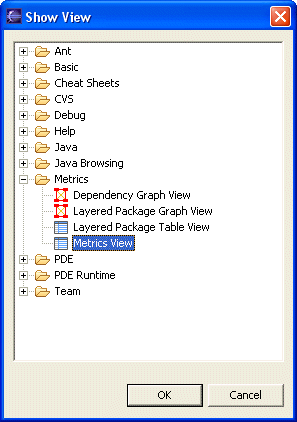 Initially the
resulting view will show a brief usage message because no metrics have been
calculated yet. To start collecting metrics for a project, right click on the
project and from the popup menu select "Metrics->Enable" (or alternatively,
use the properties page ).This will tell Eclipse to calculate metrics every time
a compile happens. Now that you've enabled a project, the easiest way to
calculate all its metrics is to do a full rebuild of that project. The metrics
view will indicate the progress of the metrics calculations as they are being
performed in the background. When it's all done, the metrics view will look
something like this:
Initially the
resulting view will show a brief usage message because no metrics have been
calculated yet. To start collecting metrics for a project, right click on the
project and from the popup menu select "Metrics->Enable" (or alternatively,
use the properties page ).This will tell Eclipse to calculate metrics every time
a compile happens. Now that you've enabled a project, the easiest way to
calculate all its metrics is to do a full rebuild of that project. The metrics
view will indicate the progress of the metrics calculations as they are being
performed in the background. When it's all done, the metrics view will look
something like this:
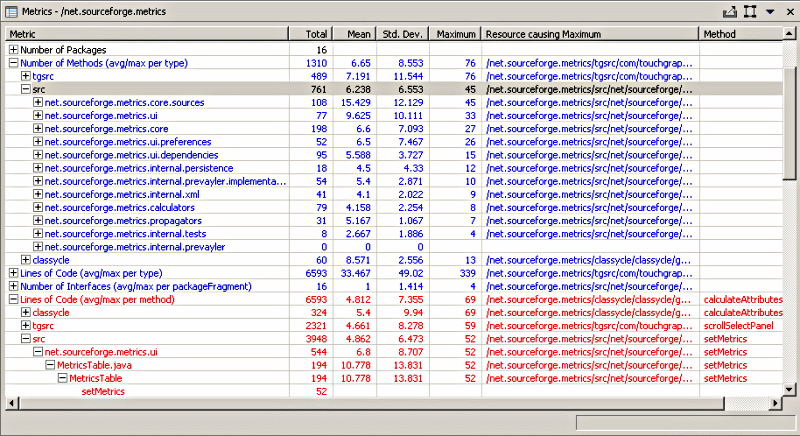 Note that any metric
shown in blue can be double-clicked to navigate to the resource causing the
maximum value for the metric. Since 1.2.0, the metrics table is actualy a table
tree, allowing you to expand each metric to show the values at levels below the
selected resource. The child elements at each level are sorted in descending
metric (maximum) value order.
Note that any metric
shown in blue can be double-clicked to navigate to the resource causing the
maximum value for the metric. Since 1.2.0, the metrics table is actualy a table
tree, allowing you to expand each metric to show the values at levels below the
selected resource. The child elements at each level are sorted in descending
metric (maximum) value order.
Preferences
The metrics preferences allow the display order of the
metrics to be changed and the metrics database to be cleared (to force
recalculation of all metrics). In addition, the toplevel preference page serves
as a category for individual metric's preference pages (category id is
net.sourceforge.metrics.ui.MetricsPreferencePage).
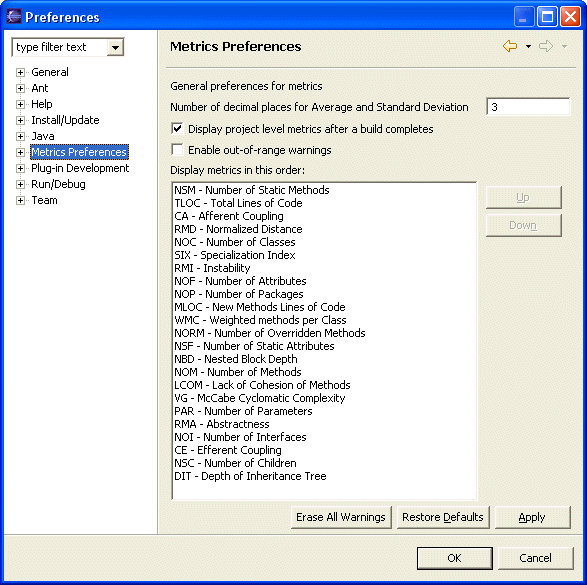 As of version 1.0.9 of the plugin, the metrics can now trigger
warnings that show up in the task view as well as the editors, indicating
methods and types for which metrics safe ranges are being violated. The minimum
and maximum for each metric can be set in the preferences. This feature is
disabled by default, and has to be enabled on the main preference page.
As of version 1.0.9 of the plugin, the metrics can now trigger
warnings that show up in the task view as well as the editors, indicating
methods and types for which metrics safe ranges are being violated. The minimum
and maximum for each metric can be set in the preferences. This feature is
disabled by default, and has to be enabled on the main preference page.
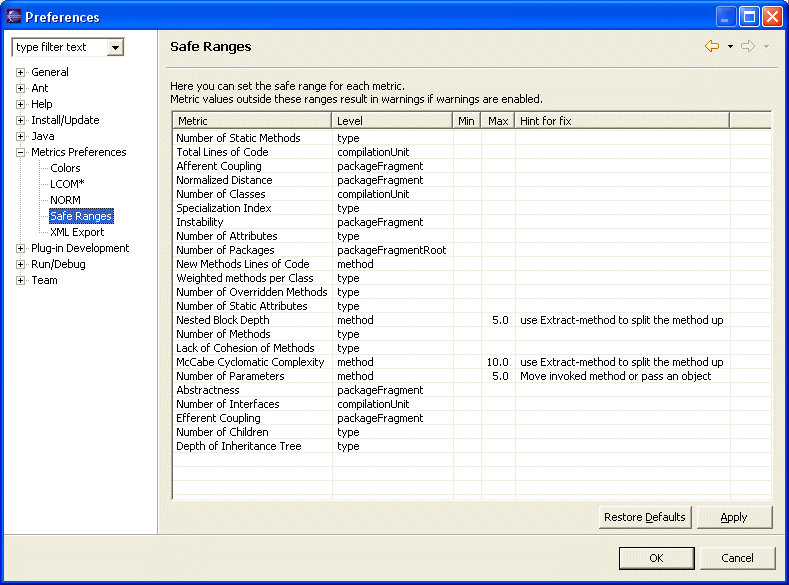
Export to XML
Metrics can be exported to an XML file to be processed
with XSL into any kind of report you want. To export metrics, select the scope
(project, package, etc.) so it is displayed in the view. Then use the view's
toolbar or dropdown menu to select the export function.

Colors
The metrics view can use custom colors for the display of
metrics. Three colors are used:
- Default color for in-range colors
- In-range color for linked metrics (those that can be double-clicked to
reveal the source in an editor)
- Out-of-range color. These are also double-clickable

Dependency Analysis
Version 1.1.0 and higher include a graphical
dependency analyzer. This view is started from the metrics view menu or
toolbar and it only works when a source folder or entire project is
selected. It shows a dynamic hyperbolic graph of the package dependencies,
which can be zoomed and rotated. Use the radio buttons and scrollbar to
manipulate the graph. The red and blue rectangles represent packages, and the
edges their dependencies. Example:
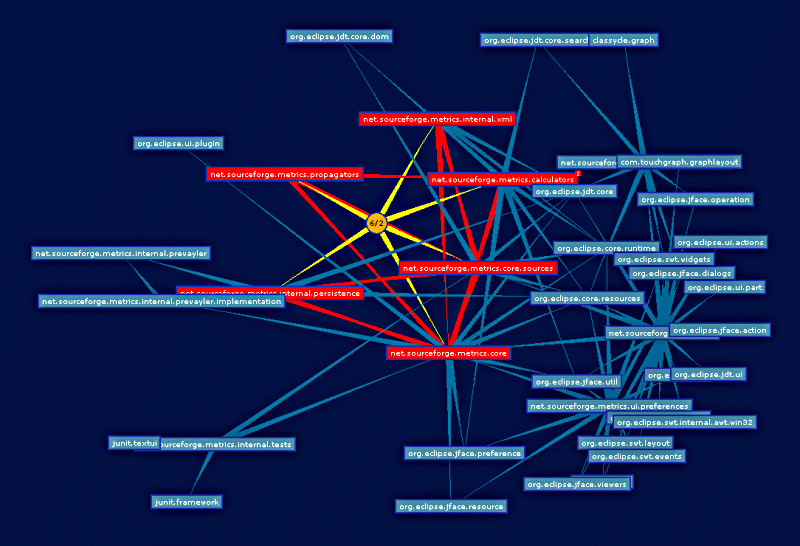 The
package dependency graph is analyzed for strong components (all nodes reachable
from each other, called "tangle" from now on) and those nodes are colored red.
Other packages not participating in cycles are colored blue. Right-click on the
background of the view to reach the popup menu listing all the tangles found in
the dependency graph. If the menu does not list any, you are in good shape and
your dependency graph has no cycles. If you select a cycle, only packages
involved in it are shown, as in the following image.
The
package dependency graph is analyzed for strong components (all nodes reachable
from each other, called "tangle" from now on) and those nodes are colored red.
Other packages not participating in cycles are colored blue. Right-click on the
background of the view to reach the popup menu listing all the tangles found in
the dependency graph. If the menu does not list any, you are in good shape and
your dependency graph has no cycles. If you select a cycle, only packages
involved in it are shown, as in the following image.
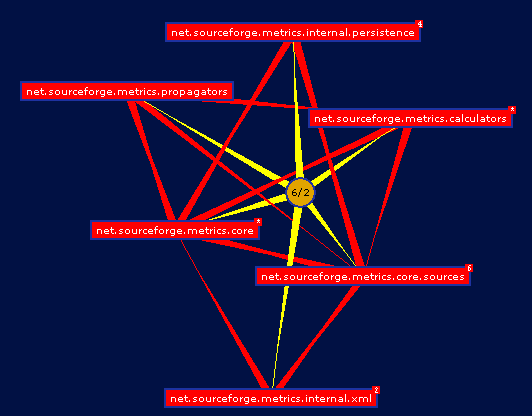 The little
yellow circle connects all packages involved in the tangle. It shows the number
of nodes involved in the tangle and the longest walk. Right-clicking on the
tangle center (the yellow circular node) shows a pop-up menu with the last entry
labeled "Analyze Details". This option invokes a search using the Eclipse search
engine for all types involved in the packages of the tangle. The result is a
more detailed dependency graph in which the nodes are types, and the
dependencies are between types. The graph only shows dependencies that cross
package boundaries. Every connection in this graph connects two classes in
different packages. The packages themselves are green rounded
rectangles. Analyzing the detail graph is best done with the hyperbolic slider
all the way to the left, so there is no curvature in the surface. In this mode,
type nodes tend to cluster around their package, but at the same time, they
gravitate towards where they are most connected. So if you notice a very long
green connection from a package to a type, but that type is located more closely
to some other package, perhaps it needs to move to that package, apparently
being more closely related to the classes in its vicinity. The next image shows
an example of this phenomena.
The little
yellow circle connects all packages involved in the tangle. It shows the number
of nodes involved in the tangle and the longest walk. Right-clicking on the
tangle center (the yellow circular node) shows a pop-up menu with the last entry
labeled "Analyze Details". This option invokes a search using the Eclipse search
engine for all types involved in the packages of the tangle. The result is a
more detailed dependency graph in which the nodes are types, and the
dependencies are between types. The graph only shows dependencies that cross
package boundaries. Every connection in this graph connects two classes in
different packages. The packages themselves are green rounded
rectangles. Analyzing the detail graph is best done with the hyperbolic slider
all the way to the left, so there is no curvature in the surface. In this mode,
type nodes tend to cluster around their package, but at the same time, they
gravitate towards where they are most connected. So if you notice a very long
green connection from a package to a type, but that type is located more closely
to some other package, perhaps it needs to move to that package, apparently
being more closely related to the classes in its vicinity. The next image shows
an example of this phenomena.
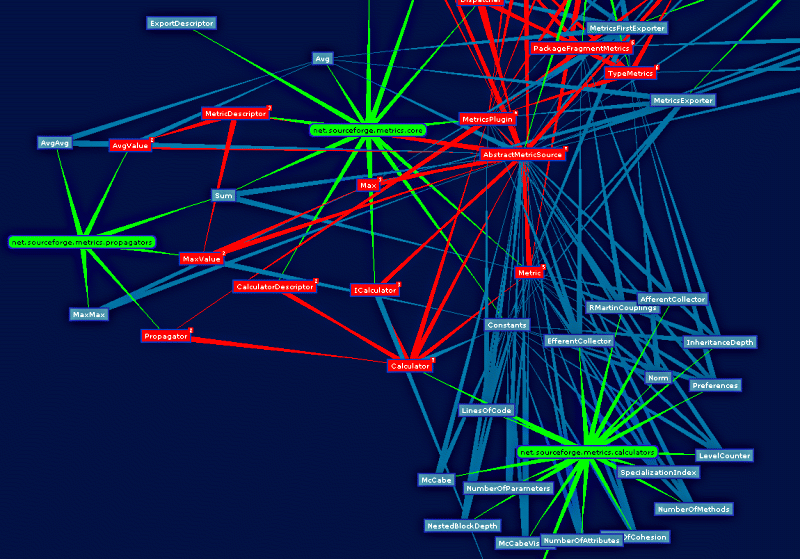 Notice the
Metric and Constants types. These seem closely related to the calculators
package, yet they are located in the core package.
Notice the
Metric and Constants types. These seem closely related to the calculators
package, yet they are located in the core package.
In the construction of these graphs, connections between a package and its
types is stronger than the connections between types. The connections between
types involved in a tangle (red) is stronger than regular connections (blue).
Think of the connections as rubber bands with different elasticity.
In large tangle it is sometimes hard to see why all nodes are connected to
each other and how. To help with that, The tangle popup menu has a "Find
Shortest Path" entry that shows the following dialog:
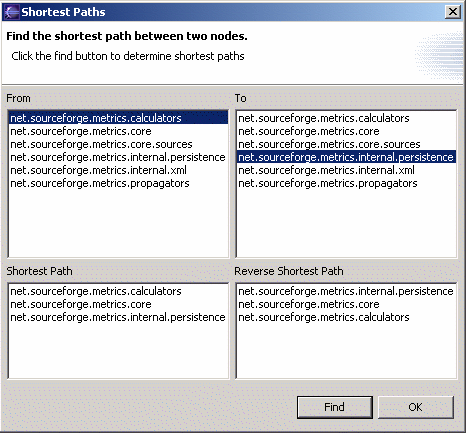
Headless operation from Ant
Warning : since version 1.3.6 the
anttask.jar as been renamed ant-metricstask.jar As of version 1.3.2 the
metrics plugin contains some ant tasks that can be used for headless operations
as part of a nightly build for example. This section describes how to do this.
Running eclipse without ui on an Ant build file
The following example
DOS batch file shows how to run a headless build using eclipse, edit to match
your environment: echo off
setlocal
set JAVA_HOME="c:\program files\jdk141_07"
set VMARGS="-Xmx256m"
REM The JRE java.exe to be used
set JAVAEXE=%JAVA_HOME%\jre\bin\java.exe"
REM The Eclipse startup.jar
set STARTUPJAR="C:\usr\Eclipse3.1\eclipse\startup.jar"
REM The location of your workspace (does not need to exist)
set WORKSPACE=C:\usr\ecworkspace
if not exist %JAVAEXE% echo ERROR: incorrect java.exe=%JAVAEXE%, edit this file and correct the JAVAEXE envar
if not exist %JAVAEXE% goto done
if not exist %STARTUPJAR% echo ERROR: incorrect startup.jar=%STARTUPJAR%, edit this file and correct the STARTUPJAR envar
if not exist %STARTUPJAR% goto done
:run
@echo on
date /t
time /t
%JAVAEXE% %VMARGS% -cp %STARTUPJAR% org.eclipse.core.launcher.Main -noupdate -application org.eclipse.ant.core.antRunner -data %WORKSPACE% -file build.xml %*
date /t
time /t
:done
pause
Note that the metrics builder determines it is running headless by
checking for the "-noupdate" commandline argument. If it finds there is no UI,
it calculates the metrics in the current (foreground) thread instead of queuing
them up and forking a background thread to perform the calculations.
Ant tasks provided by this plugin
<eclipse.build>
Convenience task because I did not like the
built-in <eclipse.incrementalBuild> task. Not strictly related to metrics
calculation and for a large part copied from an example in an article by
Barry Searle and Ellen McKay on using Ant with Websphere
Studio ApplicationDeveloper.
| parameter |
description |
| projectName (String) |
Name of the eclipse project to build |
| buildType (String) |
One of "incremental", "full" or "auto" |
| failOnError (boolean) |
"true" or "false" |
| errorOut (File) |
Compiler errors go here |
| errorFormat (String) |
One of "txt" or "xml" |
Example:
<eclipse.build
ProjectName="net.sourceforge.metrics"
BuildType="full"
errorOut="errors.xml"
errorFormat="xml"
failOnError="true"/>
<metrics.enable>
Takes only one parameter, projectName
and simply enables the metrics for that project if not already enabled. This
adds the metrics nature and build command to the .project file.
Example:
<metrics.enable projectName="net.sourceforge.metrics"/<
<metrics.export>
| parameter |
description |
| projectName (String) |
Name of the eclipse project to build |
| file (File) |
Metrics get exported to this file |
Note that
currently only the "metrics-flat-first" export format is supported.
Example:
<metrics.export
projectName="net.sourceforge.metrics"
file="metrics-metrics.xml"/>
build.xml example
<?xml version="1.0" encoding="UTF-8"?>
<project name="net.sourceforge.metrics" default="build" basedir=".">
<target name="init">
<tstamp/>
</target>
<target name="build" depends="init">
<eclipse.refreshLocal resource="net.sourceforge.metrics" depth="infinite"/>
<metrics.enable projectName="net.sourceforge.metrics"/>
<eclipse.build
ProjectName="net.sourceforge.metrics"
BuildType="full"
errorOut="errors.xml"
errorFormat="xml"
failOnError="true"/>
<metrics.export
projectName="net.sourceforge.metrics"
file="metrics-${DSTAMP}-${TSTAMP}.xml"/>
</target>
</project>
Note
To my surprise, metrics calculate just fine without the project
being built by the java builder. If your nightly build does not use eclipse to
do the compilation, you can still calculate the metrics using eclipse without
incurring a double compilation cycle. Simply remove the the java build command
from the .project file in the headless project. Also, only the source folders
have to be in the .classpath file since we're not actually compiling anything,
and the metrics builder does not use any jars on the classpath anyways.
Metrics - Meanings
The following provide brief descriptions of each
metric. In these descriptions, the word "scope" refers to the selected element
in the navigator, e.g. a project, source folder, package or compilation unit. I
used "Object-Oriented Metrics, measures of Complexity" by Brian
Henderson-Sellers, Prentice Hall, 1996 as my primary source of inspiration.
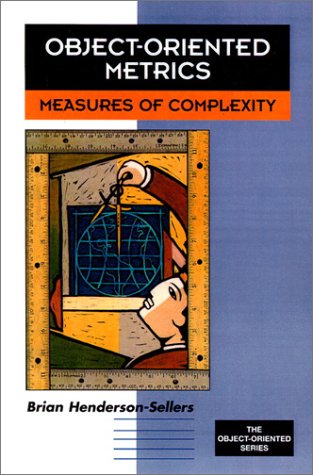
Number of Classes
Total number of classes in the selected scope
Number of Children
Total number of direct subclasses of
a class. A class implementing an interface counts as a direct child of that
interface
Number of Interfaces
Total number of interfaces in the selected scope
Depth of Inheritance Tree (DIT)
Distance from class Object in the
inheritance hierarchy.
Number of Overridden Methods (NORM)
Total number of methods in the
selected scope that are overridden from an ancestor class The calculation of
NORM can be customized from its preference page, shown below:
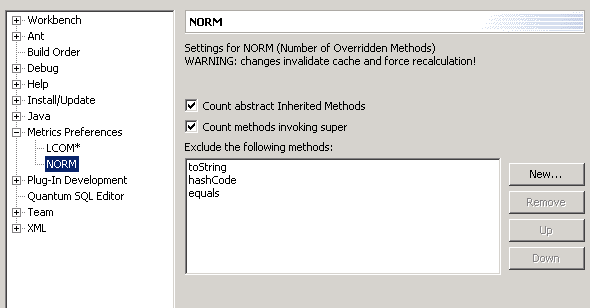 Here you can control
whether to count abstract methods, methods that call the inherited
implementation (through use of super.[same-method] call). Certain methods that
are supposed to be overridden can be excluded explicitly (like toString, equals
and hashCode).
Here you can control
whether to count abstract methods, methods that call the inherited
implementation (through use of super.[same-method] call). Certain methods that
are supposed to be overridden can be excluded explicitly (like toString, equals
and hashCode).
Number of Methods (NOM)
Total number of methods defined in the selected
scope
Number of Fields
Total number of fields defined in the selected scope
Lines of Code
since version 1.3.6 Lines of code has been changed and
separated into:
TLOC: Total lines of code that will counts non-blank and non-comment lines
in a compilation unit. usefull for thoses interested in computed KLOC.
MLOC: Method lines of code will counts and sum non-blank and non-comment
lines inside method bodies
Specialization Index
Average of the specialization index, defined as
NORM * DIT / NOM. This is a class level metric
McCabe Cyclomatic Complexity
Counts the number of flows through a piece
of code. Each time a branch occurs (if, for, while, do, case, catch and the ?:
ternary operator, as well as the && and || conditional logic operators
in expressions) this metric is incremented by one. Calculated for methods only.
For a full treatment of this metric see McCabe.
Weighted Methods per Class (WMC)
Sum of the McCabe Cyclomatic Complexity
for all methods in a class
Lack of Cohesion of Methods (LCOM*)
A measure for the Cohesiveness of a
class. Calculated with the Henderson-Sellers method (LCOM*, see page 147). If
(m(A) is the number of methods accessing an attribute A, calculate the average
of m(A) for all attributes, subtract the number of methods m and divide the
result by (1-m). A low value indicates a cohesive class and a value close to 1
indicates a lack of cohesion and suggests the class might better be split into a
number of (sub)classes.
I'm unsure of the usefullness of this metric in Java since it penalizes the
proper use of getters and setters as the only methods that directly access an
attribute and the other methods using the gettter/setter methods. Perhaps I
could alter the implementation to take this into account, assuming standard
JavaBean naming conventions.
The LCOM* metric has it's own preference page, shown below:
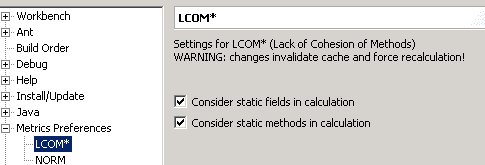 Here you can control
whether static fields and static methods should be considered in the calculation
of LCOM*.
Here you can control
whether static fields and static methods should be considered in the calculation
of LCOM*.
Robert C. Martin Suite
The following are the coupling metrics as defined
by Robert Martin in "OO Design
Quality Metrics, An Analysis of Dependencies", and more recently in his book
named "Agile Software Development, Principles, Patterns and Practices".
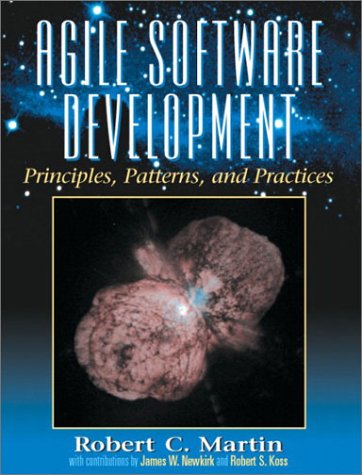
Afferent Coupling (Ca)
The number of classes outside a package that
depend on classes inside the package.
Efferent Coupling (Ce)
The number of classes inside a package that
depend on classes outside the package.
Instability (I)
Ce / (Ca + Ce)
Abstractness (A)
The number of abstract classes (and interfaces) divided
by the total number of types in a package
Normalized Distance from Main Sequence (Dn
| A + I - 1 |, this number
should be small, close to zero for good packaging design.
Licenses and Credits
The metrics plugin is CPL1.0, the same license as
Eclipse itself. It uses the following open source code by others, without these
packages, this tool would not have been possible. Thanks for all the good work!
The source to any modifications is available in the metricssrc.zip.
JDBM
I use the JDBM package as the persistence layer for the metrics.
Very cool package! I use the HTree (persistent hashtable) with a MRU Cache of
size 500. JDBM carries the BSD license and can be obtained from jdbm.sourceforge.net.
Touchgraph
The (AWT) graphing tool used for the dependency graphs. Made
some minor modifications to add popup menu entries and embedd it in Eclipse.
Touch graph was developed by Alexander Shapiro, and is LGPL. Visit http://www.touchgraph.com/ for more cool
examples and more details.
Classycle
The detection of the tangles (strong components) in the
dependency graph is based on code by Franz-Josef Elmer, classycle v 0.9, which
implements Tarjan's algorithm. This code is distributed under a BSD like
license. See http://sourceforge.net/projects/classycle
for details and updates. 












